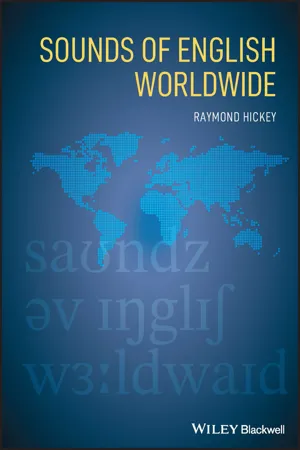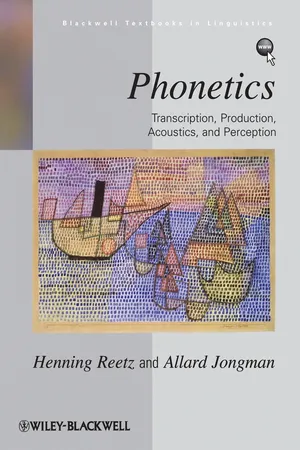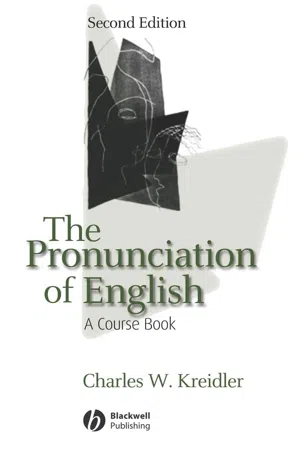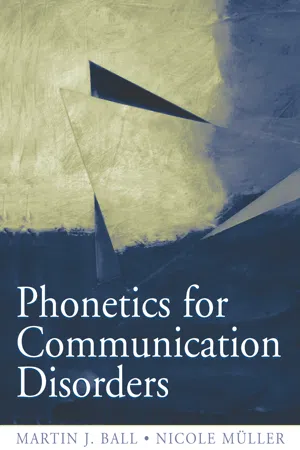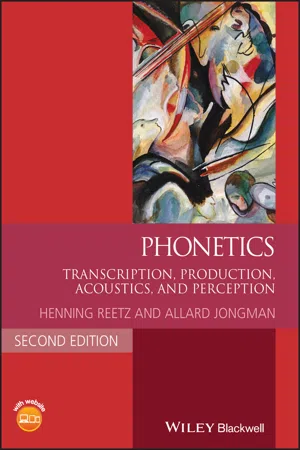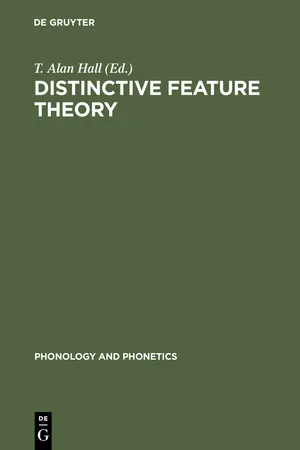Languages & Linguistics
Place of Articulation
Place of articulation refers to the location in the vocal tract where a speech sound is produced. It is a key aspect of phonetics and phonology, influencing the distinctiveness of sounds in different languages. Common places of articulation include the lips, teeth, alveolar ridge, hard palate, and velum, and the specific place of articulation of a sound can greatly impact its acoustic properties and perceptual distinctiveness.
Written by Perlego with AI-assistance
12 Key excerpts on "Place of Articulation"
- eBook - PDF
- Patricia Ashby(Author)
- 2013(Publication Date)
- Routledge(Publisher)
Place of Articulation This chapter introduces the organs of speech, studying how these relate to the concept of Place of Articulation. A distinction is made between active and passive speech organs. Places are rather like ‘ports of call’ around a coastline. In speech production, these ‘ports’ or places are the passive articulators found along the upper surface of the vocal tract – they always stay in the same position, they cannot move. They are ‘visited’ by active articulators. Specific reference is made throughout to the sounds represented in the pulmonic consonant matrix on the IPA alphabet chart. 3.1 THE ORGANS OF SPEECH 3.1.1 The vocal tract The speech organs in which we are primarily interested here are found in the supra-glottal cavities – the cavities immediately above the glottis. After flowing between the vocal folds, the first space the egressive pulmonic airstream enters is the pharynx, otherwise known as the pharyngeal cavity (or pharyngal cavity – both variants will be found in the literature, although the IPA chart uses pharyngeal). This is your throat, of course, but the more technical term tends to be familiar because of the diagnosis pharyngitis when we have a sore throat. 3 Figure 3.1 The supraglottal cavities. nasal cavity oral cavity pharyngeal cavity the glottis Place of Articulation 32 At the top of the pharynx is a choice. At this point, the airstream can enter and pass through one or both of the nasal and oral cavities – the nose and the mouth. The oral cavity is bounded on the visible, outward side by the lips. It is worth noting that the primary function of the so-called speech organs is not speech production at all, of course! Each contributes first and foremost to our survival, enabling breathing, biting, chewing and swallowing amongst other things. The fact that we have also learnt to use them to communicate is ingenious and fascinating. - eBook - ePub
- Patricia Ashby(Author)
- 2013(Publication Date)
- Routledge(Publisher)
3 Place of ArticulationThis chapter introduces the organs of speech, studying how these relate to the concept of Place of Articulation. A distinction is made between active and passive speech organs. Places are rather like ‘ports of call’ around a coastline. In speech production, these ‘ports’ or places are the passive articulators found along the upper surface of the vocal tract – they always stay in the same position, they cannot move. They are ‘visited’ by active articulators. Specific reference is made throughout to the sounds represented in the pulmonic consonant matrix on the IPA alphabet chart.3.1 THE ORGANS OF SPEECH3.1.1 The vocal tractThe speech organs in which we are primarily interested here are found in the supra-glottal cavities – the cavities immediately above the glottis. After flowing between the vocal folds, the first space the egressive pulmonic airstream enters is the pharynx, otherwise known as the pharyngeal cavity (or pharyngal cavity – both variants will be found in the literature, although the IPA chart uses pharyngeal). This is your throat, of course, but the more technical term tends to be familiar because of the diagnosis pharyngitis when we have a sore throat.Figure 3.1 The supraglottal cavities.At the top of the pharynx is a choice. At this point, the airstream can enter and pass through one or both of the nasal and oral cavities – the nose and the mouth. The oral cavity is bounded on the visible, outward side by the lips.It is worth noting that the primary function of the so-called speech organs is not speech production at all, of course! Each contributes first and foremost to our survival, enabling breathing, biting, chewing and swallowing amongst other things. The fact that we have also learnt to use them to communicate is ingenious and fascinating. - eBook - PDF
- Raymond Hickey(Author)
- 2023(Publication Date)
- Wiley-Blackwell(Publisher)
2.3 onsonnts 73 articulation, (ii) manner of articulation, and (iii) voice. 7 The last parameter is binary: present or not present. The other two involve a number of values. Place of Articulation can have any of seven values in English; in Table I.20 these are listed from left to right labeling positions at the exit of the mouth back to the throat (see Figure I.16). Manner of articulation specifies the degree of closure for a sound, i.e. the extent to which the egressive air flow is cut off or in some way constricted dur- ing articulation. Table I.20 Place and manner of articulation. Place of Articulation Labial Labio-dental Dental Alveolar Alveolo-palatal Velar Glottal Manner of articulation Closure: Complete Partial Complete + Partial Stops Fricatives Affricates Constriction: Present Absent Glides Vowels Resonance chambers when producing sounds Mouth Nose Throat Oral cavity Nasal cavity Pharynx (supra-glottal tract) Nasal cavity palate alveolar ridge Tongue (raised) Tongue (rest position) epiglottis glottis (space between vocal folds) trachea larynx lip lips labial dental Place Adjective lip teeth teeth alveolar alveolar ridge palate velum uvula uvular larynx laryngeal glottal glottis velar palatal teeth tongue tip velum uvula Figure I.16 Places of articulation. I.2 The Sound System of English 74 When wishing to classify sounds other than obstruents, further parameters are required, e.g. nasality to distinguish /d/ and /n/ or /b/ and /m/, for example. Laterality and rhoticity apply to Ls and Rs respectively. For these segments one does not need to specify voice as they are all by default voiced; the same is true for glides (in English). Consonants have an additional axis along which they vary in English, that of voice (Table I.21). All obstruents, bar /h/, come in pairs consisting of a voiceless and a voiced member (see Table I.22). - eBook - ePub
Phonetics
Transcription, Production, Acoustics, and Perception
- Henning Reetz, Allard Jongman(Authors)
- 2011(Publication Date)
- Wiley-Blackwell(Publisher)
4
Place and Manner of Articulation of Consonants and Vowels
In Chapter 3, we described the English consonants in terms of voicing, Place of Articulation, and manner of articulation. We also described the English vowels in terms of frontness, height, and lip rounding. This use of different dimensions in the description of consonants and vowels suggests that the articulation of these two classes of sounds has little in common. However, the articulatory description of both consonants and vowels is largely based on location of constriction (“Place of Articulation” in consonants, “frontness” in vowels) and degree of constriction (“manner of articulation” in consonants, “height” in vowels). It is therefore reasonable to use the terms place and manner of articulation in the description of both consonants and vowels.The speech sounds of English form a subset of all the speech sounds that have been documented across the languages of the world. Currently, it is estimated that there are approximately 6,000–7,000 languages in the world. However, many of these languages are spoken by only a few native speakers and are in danger of disappearing. Nevertheless, all languages are equally valuable. The fact that only a few people speak a particular language does not mean that this language is “strange” or “unnatural” – it is simply a consequence of historical (political or economic) developments. It has recently been estimated that more than half of all languages that are currently spoken will be extinct a hundred years from now. Fortunately, the languages that have been documented so far provide us with a rich inventory of speech sounds used throughout the world. The IPA chart on the last page of this book shows the inventory of IPA symbols that are available to transcribe many sounds of the world’s languages. It is clear that there are a large number of non-English sounds in other languages that we have not covered in the previous chapter on English consonants and vowels. It must be noted that the IPA was originally devised by Western European scientists and that the selection of sounds that are represented with single symbols still reflects those original languages, which also accounts for the left-to-right writing of the symbols to indicate a sequence of sounds. The current IPA is therefore a rather arbitrary mixture of symbols corresponding to letters of the Roman and Greek alphabets, modifications (e.g. inversion) of these letters, as well as borrowings from other writing and symbol systems. This choice of symbols has the disadvantage that the organizing principles of place and manner of articulation are not inherently represented. For example, it is not the case that all symbols representing fricatives share a particular graphic characteristic that distinguishes them as a class from all other symbols. Likewise, the symbols for all bilabials do not have anything in common. Nevertheless, the current set of IPA symbols can be used to represent most sounds of the world’s languages. - eBook - PDF
- Ingo Plag, Maria Braun, Sabine Lappe, Mareile Schramm(Authors)
- 2011(Publication Date)
- De Gruyter Mouton(Publisher)
Sounds which, like [ b ], are characterised by a constriction at the lips are called bilabial sounds (involving both lips), whereas the Place of Articulation of [ d ] is referred to as alveolar (with an obstruction at the alveolar ridge). As you can see, Place of Articulation features correspond to the articulators in-volved. Moving from the lips further to the back of the mouth, we distinguish the following places of articulation: labio-dentals involve only the lower lip and additionally the upper teeth. An example of a labio-dental sound is [ f ]. If we talk about dental Place of Articulation, however, the lips do not play a role in production. These sounds are produced with the tongue immediately be-hind the upper front teeth or even protruding between upper and lower front teeth, as in [ T ]. The latter Place of Articulation is sometimes more specifically referred to as interdental . In palato-alveolar sounds, such as [ S ], the con-striction is between the hard palate and the alveolar ridge, slightly further back than for alveolar sounds, such as [ s ]. For a purely palatal sound such as Figure 1.2. Difference in Place of Articulation: [ b ] versus [ d ] 10 The sounds: phonetics [ j ], the tongue is raised toward the hard palate. An obstruction at the velum as in [k] gives us a velar sound, and finally, if the airstream is obstructed at the glottis, as in [ h ], we talk about glottal Place of Articulation. Note that sounds with varying places of articulation also differ in terms of which part of the tongue is involved in their production. For instance, in alveolar sounds, such as [ s ] or [ d ], it is the tip of the tongue that causes the obstruction, whereas in velar sounds, such as [ k ] or [ g ], the relevant part of the tongue is the back. We have given only one sound as an illustration for each place of articu-lation here. - eBook - PDF
For the Love of Language
An Introduction to Linguistics
- Kate Burridge, Tonya N. Stebbins(Authors)
- 2019(Publication Date)
- Cambridge University Press(Publisher)
These spaces are in the mouth, nose and throat, and are called the oral, nasal and pharyngeal cavities. Sound is produced using a limited number of fixed parts of these areas. They include the alveolar ridge, upper teeth, hard and soft palate, uvula and pharyngeal wall. Also involved are more flexible parts, primarily the lips and tongue, but also the lower jaw. Together, these parts are called articulators. The upper articulators are fixed and passive while the lower articulators are active. We become very conscious of our vocal tract in situations where our ability to speak is compromised for some reason. Common situations include when we are breathless from exer- tion, when we have had too much to drink or when we lose our voice or have a blocked nose due to illness. (A sentence like Dean’s seen nineteen underground garden gnomes in Kensington North is a challenge for someone with a bad cold – try pinching your nose and saying it slowly to get the general idea.) Even a broken or lost tooth will make a difference to our speech, PHONETICS 7 Podcast Further resources Further resources 179 CHAPTER 7: Phonetics because it alters the degree of constriction we can make when producing words containing ‘s’ sounds, for example. To produce speech, air must be pushed from the lungs through the vocal folds inside the larynx, forcing them apart and causing them to vibrate. The frequency of this vibration, con- trolled by muscular tension applied to the vocal folds, is variable, and is perceived by the lis- tener as voice pitch. The tighter the squeeze, the higher the sound. Yet this is only part of the journey – once the air has passed through the ‘gates’ of the vocal folds, it has to navigate its way through an obstacle course of constrictions and blockages placed there by the articulators in order for the required sequence of vowels and consonants to be produced. - eBook - PDF
The Pronunciation of English
A Course Book
- Charles W. Kreidler(Author)
- 2008(Publication Date)
- Wiley-Blackwell(Publisher)
All nasal consonants are articulated with a flat tongue, so that these features are not distinctive for nasals. (c) Differences in articulators and places of articulation – In English the air stream may be obstructed, wholly or partially, by any one of four articulators: 34 Consonants Figure 3.1 g Upper lip m p b Lower lip Upper teeth Tip Alveolar ridge Front Velum Back Palate f v e 2 s z t d n d g a h i k the lower lip; the tip, or apex, of the tongue; the front, or blade, of the tongue (the front third of the upper surface, excluding the apex); the back, or dorsum, of the tongue (the back third of the upper surface). These articulators may be said to lie along the lower edge of the oral cavity. Along the upper edge are the areas where the articulators make contact or near-contact: the upper lip the upper front teeth the alveolar ridge, the hump behind the upper teeth the (hard) palate, the area which is separated from the nasal cavity by a bony structure the velum, or soft palate, the posterior area of the roof of the mouth with no bone above it. The interplay of articulators with places of articulation is shown in the schematic diagram of figure 3.1. Compare figure 2.2. The lines connect articu-lators and places of articulation. Symbols are placed along the lines to show what articulator and what Place of Articulation are involved in the articulation of each consonant. Nasals are on the top line, stops on the second line, and fricatives on the third line. The Place of Articulation is not distinctive for liquids, so /l/ and /r/ are not in the diagram. The positions of symbols along the lines indicate norms for articulation. As we will see, the Place of Articulation for any consonant (or any vowel) may vary somewhat according to what precedes and what follows. 3.2 Lip consonants (labials) Five consonants are articulated with the lower lip: - eBook - PDF
Introducing Linguistics
Theoretical and Applied Approaches
- Joyce Bruhn de Garavito, John W. Schwieter(Authors)
- 2021(Publication Date)
- Cambridge University Press(Publisher)
Speech sounds are generated when air is pushed through the vocal tract. The vocal tract is the area from the nose and the nasal cavity down to the vocal 2 Phonetics Christine Shea and Sarah Ollivia O’Neill 26 Phonetics cords deep in the throat. As the air passes through the vocal tract, it moves through the larynx, the pharynx, the oral cavity, and the nasal cavity. 2.2.1 Articulators In spite of the diverse number of sounds that exist in the world’s languages, humans use a small set of articulators, or speech organs (e.g., jaw, tongue, teeth, lips, hard palate) to produce all human speech sounds. The articulators are all located in the upper por- tion of the speech production system, above the larynx. Figure 2.1 shows the parts of the speech production system. Larynx Nasal cavity Palate Pharynx Velum Oral cavity Tongue Epiglottis Trachea Lungs Lungs Supralaryngeal vocal tract Subglottal Figure 2.1 Speech production system 27 2.2 Speech Production There are two types of articulators: • Active articulators: move during the production of a speech sound to form a closure of some type in the vocal tract. For example, when we articulate the first sound in the word tea, our tongue moves to the roof of our mouth, just behind our teeth. The tongue, in this case, is the active articulator because it moves towards the roof of our mouth, which does not move and is the passive articulator. • Passive articulators: do not (typically) move and are often the point of contact for an active articulator. For example, when English speakers produce the sound ‘g’, the back of the tongue is the active articulator and the velum (see Figure 2.1) is the passive articulator. When we name sounds, we typically refer to the passive articulator. In Table 2.1 you can see some examples of speech sounds produced by different com- binations of passive and active articulators. - eBook - PDF
- Martin J. Ball, Nicole Muller(Authors)
- 2014(Publication Date)
- Psychology Press(Publisher)
4. What places of articulation lie outside the oral cavity, and how do the labels of these differ from labels for other places of articulation? S. Tn the articulatory description of consonants, what is the three-term label? 6. Give some examples where the three-term label is not sufficient for the articulatory descrip-tion of a consonant. 7. Describe the main characteristics of the spectrographic signatures of plosives, affricates, and fricatives. 8. Describe the main characteristics of the spectrographic signatures of nasals and approxi-mants. Study Topics and Experiments 1. In a textbook on child language acquisition, look up the typical sequence of the acquisition of consonants. What patterns do you find concerning the acquisition of different places of articulation, and what do you think may cause the pattern in terms of the motor control required for the production of different places of articulation? 90 CHAPTER 7 2. Compare spectrographically the acoustic nature of nasal and oral sounds. Record the nasal stops [m] and [n] in the context of preceding and following [a]: [ama], [ana]. Use a good tape recorder with an external microphone. Input these into a speech analysis program, and print out a wideband spectrogram of each token. Comment on the difference between the oral and nasal segments, paying particular attention to formant structure and intensity. CD Listen to the examples of different consonants, and try to imitate as many as possible. Following the instructions on the CD, see if you can identify the test examples. Answers to all the exercises are provided at the end of the book. 8 More on Consonants INTRODLJC1'ION In the previous two chapters we have looked at the manners and places of articulation of consonants. There are some aspects of consonant articulation also important for the speech clinician that we have not yet examined, and these are the focus of this chapter. First, we are going to look in more detail at oral stops. - eBook - PDF
Phonetics
Transcription, Production, Acoustics, and Perception
- Henning Reetz, Allard Jongman(Authors)
- 2020(Publication Date)
- Wiley-Blackwell(Publisher)
Place and Manner of Articulation of Consonants and Vowels 65 Of these four types of secondary articulation, labialization is the most common across the world’s languages. While secondary articulations are phonemic in certain languages, they are represented by means of diacritics in IPA. In this chapter, we have tried to illustrate the great variety that exists in terms of place and manner of articulation in consonants and vowels of the world’s lan-guages. Needless to say, this is not a complete listing of all sounds in the languages of the world. But this chapter should enhance the appreciation of the many differ-ent ways in which speech sounds are produced in languages other than English. Which sounds are perceived as more or less “exotic” will of course for a large part depend on the native language of a speaker. The next chapter describes the airflow from the lungs to the lips and nostrils in detail. Chapter 6 then describes additional consonants that are produced with an airstream that does not originate in the lungs. Exercises 1. Choose several of the shaded cells from the IPA chart, and try to explain why these articulations are considered impossible. 2. In what way could the production of [m] in ‘emphasis’ differ from the one in ‘empire’? Why? 3. Why are dental, alveolar, and postalveolar combined into one column in the IPA chart? 4. Explain how taps and trills are produced differently, and give one example of each. 5. Why are some vowels that contrast length transcribed with diacritics ([ ɛ ] and [ ɛː ]) while others are transcribed with separate symbols ([ ɪ ] and [i])? 6. What is a secondary articulation? Summarize and give examples of four types of secondary articulation. Notes 1. This chapter does not have a “nutshell” section, since it adds more consonants and vowels to the IPA tables introduced in Chapter 3. 2. See the website www.internationalphoneticassociation.org/content/ipa-handbook-downloads and www.phonetics.ucla.edu. - eBook - PDF
Language Files
Materials for an Introduction to Language and Linguistics, 13th Edition
- Department of Linguistics(Author)
- 2022(Publication Date)
- Ohio State University Press(Publisher)
(To conceptualize what this means, think about your mouth: your tongue is an active articulator because it moves, but your alveolar ridge is a passive articulator because it is involved in articulation only when your tongue touches it.) Phonetics 92 The same sort of thing (primes that are available in one signed language but not an- other) occurs for kinds of movement and places of articulation. Some languages have a movement that is a side-to-side twisting of the wrist; others do not. Some sign languages have [crown of the head] as a Place of Articulation; others do not. There are many things, of course, that you can do with your hands and arms—just as there are many things you can do with your mouth. Some of these, such as swallowing, whistling, throwing a ball, or brushing at a mosquitos, are nonlinguistic, while others may be linguistic. It is important to remember, though, that just because a certain kind of articu- latory gesture may have linguistic applications does not mean that any given language necessarily uses it. 2.7.9 Studying and Analyzing the Phonetics of Signed Languages A number of innovations that help researchers discuss, describe, and research the articula- tion of spoken languages were discussed in previous files. There have been fewer techno- logical innovations for the study of phonetics in signed languages, in part because the sign language articulators are large, slow, and not covered by your cheeks. In other words, they are a lot easier to study in a straightforward way than are the articulators of spoken languages! But this is also due to the fact that the study of signed language phonetics is simply newer than the study of spoken language phonetics. Of course, one tool that has been very helpful is simple video recording, which allows researchers to look at the same segments over and over again. More sophisticated technology involves attaching sensors to various parts of signers’ hands, arms, face, and so on. - eBook - PDF
- T. Alan Hall(Author)
- 2012(Publication Date)
- De Gruyter Mouton(Publisher)
The sub-component of the tree relevant to the issue at stake here is the Place node, shown in (2). The Place node dominates the Articulator node, which organizes the Place of Articulation features, and the Aperture node, which organizes the height features (Lahiri and Evers 1991, Ghini 1998). 152 Mirco Ghini (2) Place Articulator Aperture / Labial Coronal Dorsal Low High Posterior Distributed Vowels and consonants share the same features (Clements 1989, 1991; Clements and Hume 1995), as well as the same organizing nodes (Lahiri and Evers 1991, Ghini 1998), but are subject to different well-formedness constraints (Ghini 1998). Vowels, for example, can only be specified for [Labial] if another place of arti-culation feature has been previously specified, e.g. [Coronal] for front vowels and [Dorsal] for back vowels. This gives [Labial] the status of a secondary feature for vowels. The constraint on the occur-rence of [Labial] in vowels is expressed in (3). (3) Constraint on [Labial] (Ghini 1998): Vowels can be specified for [Labial] iff another Place of Articulation feature is already available. The presence of [Coronal] is not banned altogether in underlying representations. If a system contrasts units within the coronal space of articulation, then [Coronal] is activated (Avery and Rice 1989). A system can even contrast underlying coronals with units lacking underlying specification for Place of Articulation (Ghini 1998). In sum, the underlying presence of [Coronal] is marked and is taken to directly mirror the markedness of the systems which make use of it underlyingly. I turn now to the illustration of the vowel system in Miogliola Liguri an. Place of Articulation first 153 3. Miogliola Ligurian Vowels The chart in (4) shows the Miogliola Ligurian short vowel phonemes in stressed position organized according to phonetic principles.
Index pages curate the most relevant extracts from our library of academic textbooks. They’ve been created using an in-house natural language model (NLM), each adding context and meaning to key research topics.


